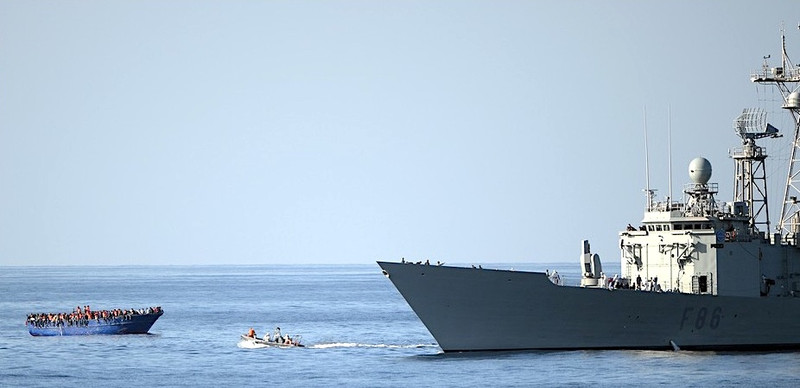On the heels of one of the deadliest boat sinking of migrants off the Greek coast, with at least 78 dead and possibly many more, warnings are emerging that last week’s political agreement on asylum will compel EU states to engage in even greater numbers of illegal pushbacks.
Those fears are embedded in a formula that determines how many people, including children, will be sent to detention-like centres as part of a fast-track, 12-week border procedure.
“The whole thing basically incentivises countries at external borders to try to stop people from ever arriving at their border in the first place. And that equals pushbacks,” said Stephanie Pope, an asylum expert at Oxfam.
The border procedure is reserved for nationalities with a 20 percent or lower chance of asylum. The more people are sent to such centres, the more an EU state has to take on responsibilities for their care and eventual return.
This may require erecting EU-funded barbed-wire facilities with watchtowers, such as those found on the Greek islands, posing tricky questions for the locals as wells fundamental rights issues for those locked up.
They will also have to return them. But this only compounds the problems because many origin countries simply refuse to take back their own nationals. Only 18.5 percent of people issued a return decision last year actually left.
Yet last week, EU interior ministers agreed that a minimum of 30,000 people should have their applications processed in a border procedure every year.
The form for calculating an individual country’s capacity to process its share of the 30,000 is based on the number of people who arrive irregularly to seek asylum.
It means the more irregular entries a member state has, the greater its share of having to fast-track people at the border and send them home.
The incentive then is to reduce the irregular entries of people seeking asylum, which typically entails pushbacks or convincing other countries, like Tunisia, to intercept people on boats.
Tug-of-war
The issue is part of a much bigger tug-of-war between responsibility and solidarity among northern and southern EU states.
And it is a fight that involves a dysfunctional system known as ‘Dublin’, whereby the country of first entry is required to handle an asylum application.
Some asylum seekers leave their first country of entry, for instance Italy, to then ask for asylum in Germany. Germany may then ask Italy to take back that person, a request that usually goes unanswered.
Around 1 million migrants and asylum seekers arrived in Italy between 2013 and 2023.
Out of that, an estimated 700,000 left Italy with Rome welcoming back less than 35,000 on its territory, according to the Italian Institute for International Political Studies, a think-tank.
It means Italy is hosting only 0.2 percent of refugees, in terms of its population size, compared to 0.7 percent in France and 1.5 percent in Germany.
Under the current Dublin rules, if that person is not sent back to Italy within 12 months, then the responsibility shifts over to Germany.
In other words, the current broken Dublin system works in favour of Italy because migrants are self-relocating to other EU states.
Northern members states are trying to curtail this by placing brakes on the border-free Schengen zone.
At least six EU states, since 2015, have re-erected internal border controls to stem so-called secondary movements of migrants and asylum seekers.
They are now shoring up the Dublin rules as well. Last week’s agreements means the 12-month deadline has been extended to 2 years, and even three in case an asylum seeker absconds.
This works against Italy’s interests, posing questions on why Rome would accept the deal given that the solidarity aspect of the equation has been left waning.
“In this proposal, everything that Italy should have been against, has passed,” said Matteo Villa at the Italian Institute for International Political Studies.
Some suggest that Italy agreed because it managed to weaken rules when it comes to sending rejected asylum seekers to so-called safe third countries.
Lending weight to that argument is an €1bn EU aid package to Tunisia to stem migration, despite its president showing little interest in policing migrants on the behalf of Europe.
Meanwhile, EU interior ministers have eschewed any notion of mandatory relocation, a system where arriving asylum seekers are shared among EU states.
Instead, they agreed to a voluntary system and have set the annual relocation number to 30,000. An option to pay €20,000 for every asylum seeker not relocated was also tabled.
But past experience suggests even this number won’t be reached.
Last year, the French EU presidency attempted to get 10,000 pledges for a voluntary relocation plan.
As of April, only around 880 were relocated. Initially billed as historic, the French inspired plan is no longer a talking point among EU spin-doctors.
A mandatory EU relocation scheme from 2015 to help Italy and Greece met a similar fate, triggering lawsuits from Hungary, Poland, and the Czech Republic.
Just under 13,000 were relocated from Italy at the time. Over the same period, some 350,000 had landed on its shores, meaning just under 4 percent were relocated.
Trust
EU officials and ministers are now saying that trust has now been restored, claiming the political agreement reached on 8 June among interior ministers is proof.
“The decision today actually proves that now there is trust between the member state,” Ylva Johansson, the EU migration commissioner, told reporters after the agreement.
Trust is an abstract notion, as are the criteria for measuring it, however.
Poland and Hungary voted against the proposals, and four other countries abstained — Malta, Bulgaria, Lithuania and Slovakia.
Germany is upset over plans to shuffle children into the border procedure. And Ireland, along with Poland and Hungary, are framing the €20,000 option not to relocate as a fine.
But after seven years of failures on asylum among EU states, the 8 June agreement remains politically significant. Yet does the agreement mean that trust has been restored?
Not according to Alberto‑Horst Neidhardt, an analyst at the European Policy Centre. “It is not so much restoring trust, but replacing the lack of trust with rules,” he said.
“I think these can create a negative vicious circle, and also is the result of a negative vicious circle,” he added, noting possible non-compliance issues ahead.
Nuts and bolts — what’s next?
There are a total of 11 files under the EU asylum and migration pact. The plan is to get them finalised by April next year, ahead of the European elections and the rotating presidencies of Hungary and Denmark.
Five have already been agreed among co-legislators: qualification regulation, reception conditions directive, resettlement framework regulation, EU asylum agency, and the EU blue card.
Negotiations have been on-going on three: Eurodac, screening and asylum procedures regulation, while talks started this week on the asylum migration management regulation and the single-permit directive.
This leaves the crisis proposal, returns directive, and long-term residence directive.
But efforts are also under way to revive the instrumentalisation regulation, a proposal that scales back asylum rights whenever countries like Belarus or Turkey force large numbers of people across an EU border.
The idea is to merge it with crisis proposal, another large bill that lays out the rules whenever an EU state is overwhelmed with arrivals.
That will be the task for the upcoming Spanish EU presidency.
By NIKOLAJ NIELSEN
Source: EU Observer



